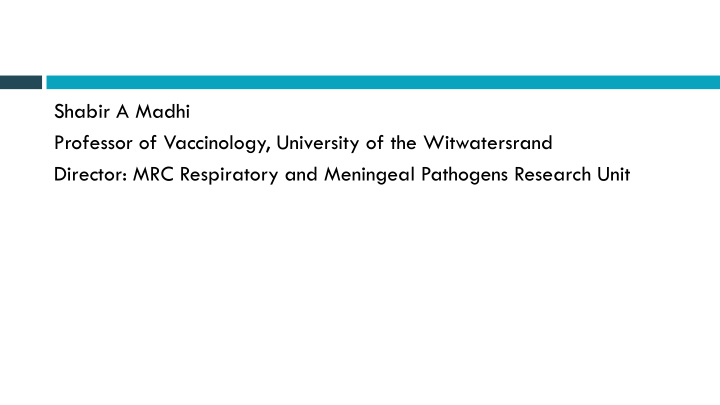



Shabir A Madhi Professor of Vaccinology, University of the Witwatersrand Director: MRC Respiratory and Meningeal Pathogens Research Unit
Virus: A “non - living” infective agent, only able to multiply in living cells of a host. Mainly droplet spread transmission: possibly direct inoculation. Self-inoculation following contact with contaminated surfaces. Exact numbers infected unknown, since sensitive to who is tested (bias against asymptomatic and mild illness). Reproductive rate of ~2.5 and case fatality rate 1-2% . Expect “herd immunity” once approximately one -third of population are infected.
What to expect from SARS-CoV-2, which causes COVID-19. • 20-80% asymptomatic (carrying virus but not ill). % Died % ICU • Of the symptomatic (fever or respiratory symptoms),10- % Severe 15% with severe illness. disease % Symptomatic • Approximately 5% require ventilation/ICU % Asymptomatic • Case fatality risks 1-2% (variable based on denominator); % Infected and differ with co-morbidities. Total Population
Global burden of COVID-19: 3 April 020
Geographic distribution of cumulative number of reported COVID-19 cases per 100 000 population, worldwide, as of 26 March 2020
Country distribution of COVID-19 cases (29 March 2020) The number of confirmed cases is lower than the number of total cases; due to limited and/or restrictive testing criteria. Case fatality risk (CFR) (26 Mar) 1.5% 10.2% 4.5% 7.6% 5.9% 7.6% 5.8% 1.6% 5.0% 1.5% 5.8% • Case fatality risk (CFR) does not account for cases still under treatment (may be higher) • Differences in threshold for investigating will influence CFR. • Differences in population demographic and co-morbidities affect attack rate and CFR
Country distribution of COVID-19 cases (3 Apr 2020) The number of confirmed cases is lower than the number of total cases; due to limited and/or restrictive testing criteria.
Risk for infection similar across age-group, but older individuals more susceptible to fatal outcome. Case fatality risk: • ?HIV (7 million) and TB (300,000) • Seasonal influenza 40-fold increased risk mortality in PLWH
Covid-19 cases as of 2 April 2020 in South Africa The number of confirmed cases is lower than the number of total cases; due to limited and/or restrictive testing criteria. • Biases in terms of select group tested. • Majority of testing in private sector and using algorithm geared toward detecting imported cases and their contacts. • Emergence of “sporadic cases”, including health care workers - indicating community transmission. • Current figures an under-estimate of burden of COVID-19 in SA, yet doubling time of three days.
Covid-19 cases as of 29 March 2020 in South Africa The number of confirmed cases is lower than the number of total cases; due to limited and/or restrictive testing criteria. • Biases in terms of select group tested. • Majority of testing in private sector and using algorithm geared toward detecting imported cases and their contacts. • Emergence of “sporadic cases”, including health care workers - indicating community transmission. • Current figures an under-estimate of burden of COVID-19 in SA, yet doubling time of three days.
Doubling time of 3-4 days in number of COVID-19 cases, despite very restrictive threshold for testing. Projection based on restrictive testing algorithm, and no intervention. Expect acceleration in number of cases with change in criteria for testing (i.e. irrespective of travel or contact. Likely reduction in doubling time to 24 hours. Change in demographics and outcome with changes in testing algorithm.
Spatial distribution of COVID- 19 cases in Johannesburg: Absence off identifying cases ≠ absence of disease The number of confirmed cases is lower than the number of total cases; due to limited and/or restrictive testing criteria. Urgent need for scaling up of testing facilities, with low threshold for indication for testing across the country, and especially in major metro in Gauteng, WC, KZN.
Source: Morgan Stanley, Johns Hopkins CSSE
Where are we in the epidemic??? The number of confirmed cases is lower than the number of total cases; due to limited and/or restrictive testing criteria. Current numbers significantly under-estimate actual number of infections and COVID-19 cases. Expect an even more accelerated increase in COVID-19 cases once testing more available and change criteria for testing.
South Korea cases Testing rate: South Korea: 1 per150 individuals South Africa: 8 per 10,000
South Korea cases
“Countries can't simply lock down their societies to defeat coronavirus” Mike Ryan, WHO, Assistant Director General for Emergencies “What we really need to focus on is finding those who are sick, those who have the virus, and isolate them, find their contacts and isolate them”. “The danger right now with the lockdowns … if we don’t put in place the strong public health measures now, when those movement restrictions and lockdowns are lifted, the danger is the disease will jump back up.”
What to expect from the lockdown Free-for-all Attempted quarantine/lockdown Moderate distancing Extensive distancing https://www.washingtonpost.com/graphics/2020/world/corona-simulator/
Considerations Duration of lockdown? Implication of residual circulation of SARS-CoV-2, post lockdown Social distancing and other precautionary/preventative measures Role of higher institutions in supporting Government response Implications for academic year in higher education Community mobilisation at multiple fronts
Priority areas for action Scaling up Country-wide Diagnostic Capacity Safety and Protection of Frontline Healthcare Personnel Increase Access to Mandatory Influenza Vaccination Centralized and Decentralised Containment Areas Enhance Clinical Care Capacity Systems Management and Logistic Support for Public Hospitals Immediate Private- Public Healthcare Partnership Agreement Psychological Preparedness and Support for Frontline Healthcare Personnel. Community mobilisation at multiple fronts
Recommend
More recommend